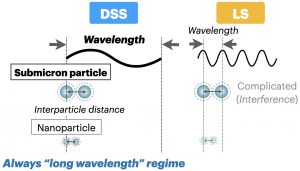Published: Dynamic ultrasound scattering from Concentrated Suspensions
March 24, our paper entitled “Nano and Submicron Particle Sizing in Concentrated Suspension by Dynamic Ultrasound Scattering Method”, by Kana Kitao, Misaki Tani, Manami Yamane, Shinichiro Inui, Mao Yamada, and Tomohisa Norisuye, has been accepted for publication in Colloids and Surfaces A: Physicochemical and Engineering Aspects, Elsevier (DOI:10.1016/j.colsurfa.2024)
The high-frequency-dynamic ultrasound scattering (DSS) method, an ultrasonic analog of the dynamic light scattering (DLS) method, is a method that can obtain particle size from diffusion measurements of nanoparticles without dilution in liquid while using long wavelength ultrasound. While we have already achieved highly accurate nanoparticle measurements[1], this paper describes a method for high concentration samples (up to 30 vol%). Although recent DLS studies have presented techniques that can measure concentrated systems, this study describes a method that fundamentally avoids the problems inherent in light by using ultrasonic waves.

Figure 1 The dynamic ultrasound scattering (DSS) method determines the size of particles from the rate of time relaxation of the correlation function. It is possible to measure even samples with concentrations such that light cannot transmit through them.
Our development of the high-frequency DSS method was prompted by the development of the ultrasonic correlation spectroscopy (dynamic sound scattering) method [2] or acoustic diffusing wave spectroscopy [3] by John Page et al. in Manitoba Canada. These techniques were successfully employed to study sub-millimeter complex fluid dynamics and wave propagation with multiple scattering at relatively low frequencies of around 2 MHz. On the other hand, as a materials science technique, it was not possible to detect micron-sized particles and nanoparticles. This requires high-frequency ultrasonic emission as well as technology to narrow the bandwidth of broadband sensors (like lasers). One can imagine how difficult it is to measure nanoparticles, because for the same concentration, the signal strength is reduced by a factor of 1000 when the particle size is reduced by a factor of 10. We have developed a completely new high-frequency ultrasound transmission/acquistion (Nano-DSS[1]) and analysis system (FD-DSS[4]) to realize nanoparticle measurement.

Figure 2 Interference between particles occurs as concentration increases, but because ultrasound has a long wavelength, particles in a concentrated system can be evaluated using the long wavelength concept for both nanoparticles and submicron particles.
The DSS method now can be used to measure nanoparticles with high concentration, but it is even more powerful for submicron particles with high concentration. Submicron particles, which are about the same diameter as the wavelength of light, cause strong Mie scattering of light, and the problem of light not transmiting the optically opaque sample and the complexity of analysis due to multiple scattering are often discussed. However, a problem inherent to highly concentrated samples is the consideration of structural configuration due to the arrangement of the particles and the more complex hydrodynamic interactions that are triggered. Therefore, even when light could transmit through the concentrated suspension, the diffusion coefficient that can be measured by DLS depends on the scattering angle (the scattering vector dependence oscillates periodically), making it difficult to determine the particle size. Our proposal was to use ultrasound, which has a longer wavelength, and once the target is a large particle analysis, such as a micron particle, then to achieve a more nano-level structural analysis through technological innovation. Since nanoparticles and submicron particles are much smaller than the wavelength of ultrasound, the structure factor can be replaced by the thermodynamic compressibility and the hydrodynamic function by the sedimentation function, so that the results are not influenced by spatial scale parameters. This fundamentally solves the problem of particle size analysis methods specific to concentrated systems.
For more information, please read the paper.

Figure 3 The diffusion of particles associated with Brownian motion is a mode of coherent motion in a large scale (cooperative diffusion) and a mode of individual motion in a small scale (self-diffusion). As the concentration of particles increases, the former becomes faster and the latter slower, but as the concentration of submicron particles is increased, both effects can be seen. Because ultrasound has a long wavelength, a simple and quantitative analysis of the cooperative diffusion coefficient is always possible.
[1] Kitao, K., 2022, Nanoparticle Sizing by Focused-Beam Dynamic Ultrasound Scattering Method, Ultrasonics, 126, 106807.
[2] Cowan, M. L., 2000, Velocity Fluctuations in Fluidized Suspensions Probed by Ultrasonic Correlation Spectroscopy, Phys. Rev. Lett., 85, 453-456.
[3] Page, J. H., 2000, Diffusing acoustic wave spectroscopy of fluidized suspensions, Phys. B, 279, 130-133.
[4] Igarashi, K., 2014, Dynamics of submicron microsphere suspensions observed by dynamic ultrasound scattering techniques in the frequency-domain, J. Appl. Phys., 115, 203506.
